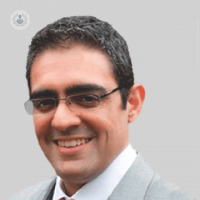All about minimally invasive bunion surgery
Written in association with:Leading orthopaedic surgeon Mr Adam Ajis provides a detailed insight to minimally invasive bunion surgery in this informative article.

Am I a good candidate for minimally invasive bunion surgery?
Although minimally invasive bunion surgery can be carried out on any level of deformity, I find patients tend to do better when they present earlier on in their journey when the deformity is not quite so severe. Bone quality has to be good and you will be advised to rest and elevate for six weeks.
What are the different types of minimally invasive bunion surgery available, and which one is best for me?
Minimally invasive bunion surgery has been available for quite some time now and there are different ways of performing it. The latest generation of minimally invasive bunion surgery involves making a cut in the first metatarsal bone, which supports the big toe, moving it back into its corrected position and holding it there with screws that are buried into the bone.
Techniques have evolved in achieving this and the latest generations involves using jigs to guide the screws more accurately and quickly. This improves:
- alignment;
- deformity correction and;
- screw position.
This is typically what I recommend for the majority of patients suitable for keyhole or minimally invasive bunion surgery.
What are the potential benefits and drawbacks of minimally invasive bunion surgery compared to traditional surgery?
The benefits of minimally invasive bunion surgery include a quicker resolution of post-operative swelling, less scarring and soft tissue damage and a faster return to full function. It can be limited however by the initial deformity and sometimes a more powerful correction can be achieved with open techniques.
The bone takes six weeks to heal to be strong enough to return to comfortable loose-fitting footwear. Then, it remodels and becomes even stronger over the coming months. Traditional open surgery can sometimes be a better option for people with severe deformity or osteoporotic bone.
What is the recovery process like after minimally invasive surgery?
There is typically no pain immediately after surgery as I place local anaesthetic around all the nerves supplying the foot. When this wears off, it takes the worst of the pain away with it.
Most of my patients tell me they stop taking painkillers are the first week following surgery.
During the first six weeks, rest and elevation is recommended with minimal mobilisation. Sutures can be removed and the incision sites checked at two weeks following surgery. The foot can then be wet in a shower or bath.
A special post-operative shoe is worn for six weeks for protection. X-rays to check on healing and bone position are performed at the six-week stage. Running and impact activities can start after three months.
What are the long-term outcomes of minimally invasive bunion surgery?
As with any type of surgery, there are unexpected risks or complications. There is always a small risk of infection, a small risk of deformity recurrence, sometimes the screws can become loose and become prominent, requiring their removal at a later date.
There is also a small risk of blood clot in the legs, which can travel to the heart. There is a risk of stiffness in the big toe and numbness around the scar. There is a very rare risk of disruption to the blood supply to part of the bone.
Interested in minimally invasive bunion surgery? Arrange a consultation with Mr Ajis via his Top Doctors profile.


